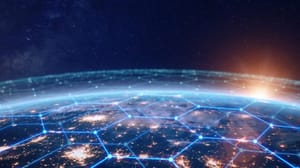The promise of international terrestrial cables for resilient global connectivity
With global connectivity demands intensifying, cable providers are increasingly looking to redraw the map – over land.
August 29, 2023

Telecoms.com periodically invites expert third parties to share their views on the industry’s most pressing issues. In this piece Gavin Rea, Chief Technical Officer at Gulf Bridge International (GBI), examines the increasingly important role terrestrial cables play in the global connectivity mix.
Having spent 30 years in the subsea cable industry, it’s very easy to forget about the remarkable transformation the sector has experienced. Like anything, cables possess a rich history that have followed the current of global technology innovations driving broader change.
While these feats of engineering were first developed in the mid-nineteenth century, it was in the 1980s that we saw the birth of fibre optic – the first wave of modernisation that can be associated with the cable ecosystem we know today.
Fast-forward another 40 years and we are now reaching another turning point for the cable industry. With global connectivity demands intensifying, cable providers are increasingly looking to redraw the map – over land. They are ambitious and challenging projects, but when done right, terrestrial cables can enhance the resilience of global connectivity.
Subsea capacity strains
The Suez Canal has for centuries stood as a vital trade artery connecting the East and West. Leveraging its strategic geography, Egypt today stands as a prominent global connectivity hub. The region now handles as much as 17-30% of all worldwide internet traffic – with the Red Sea as a primary tributary.
However, like the early pioneers of engineering envisioned in the 1850s, the Suez Canal lifeline would eventually ‘silt up with sand’. This metaphor perfectly captures the current situation in Egypt, with connectivity bottlenecks and congestion placing strain on its subsea cables.
For the 16 cable routes passing through the region, they face these pressures head on, forcing the likes of Google and other hyperscalers to invest in their own cable networks.
Hyperscale investment
With so many of the world’s largest organisations looking to expand the reach of their services into new markets, it makes sense that they would begin to invest in their own infrastructure to maximise access and control.
It’s important to also consider that these investments are driven by weaknesses in the global subsea network to keep up with the emergence of disruptive economies channelling global investment. The Middle East is one example thanks to its remarkable digital growth, with internet penetration in the region increasing by 20% annually.
With each new cable that is developed, the wider industry stands to benefit – allowing partners to use these cables either as primary routes or as back-ups to provide service assurance.
Going over land
Terrestrial cables offer an obvious alternative to this and are host to a range of benefits for the regions and businesses they connect with. These networks bridge global connectivity via shorter, more direct routes to proliferating digital hubs. They also provide assurance guarantees to content and data centre providers already operating around these regions.
In current conversations, terrestrial routes are viewed as ambitious projects. This can be explained by the host of technical, commercial and political complexities associated with them, including interaction with national borders and greater exposure to acute environmental fluctuations.
It is for these reasons why subsea cables were the most common and effective way of bridging global connectivity over the last century. However, in an era where we are seeing unprecedented data consumption in new regions, offering terrestrial cables provides a compelling solution where they are possible.
The promise of terrestrial cables is enormous, taking up a healthy slice of the predicted $10 billion investment in the sector over the next 2 years. In the Middle East, terrestrial cables have the potential to circumvent saturated cable routes through the Red Sea, offering crucial layers of diversity and assurance to areas historically suffering from internet traffic oversaturation.
With a significant volume of internet traffic flowing through cables via Egypt, the deployment of land cables along both north and south routes creates numerous connectivity pathways. This not only relieves capacity strains but also provides alternative cable options, leading to enhanced network redundancy. The result is a more seamless interaction between the region itself and the world, promising a more resilient global network.
A connected future
To future-proof global connectivity, it’s vital that cable providers continue to diversify their networks. Opting for a terrestrial or land cable ultimately depends on the regions you are connecting and their respective capacity requirements, and with each new cable, the community stands to benefit.
In an era where we are seeing the growth of new digital hubs – such as Iraq in the Middle East – the provision of terrestrial cables offers incredible benefits for their access to major digital services and global communities. When done right, they can enhance the overall resilience of global connectivity and alleviate pressures on the cable network.
 Gavin Rea is Chief Technical Officer, GBI. Gavin has over three decades of extensive management and industry experience in the development, delivery, operations & maintenance of international and domestic submarine telecommunications cable systems.
Gavin Rea is Chief Technical Officer, GBI. Gavin has over three decades of extensive management and industry experience in the development, delivery, operations & maintenance of international and domestic submarine telecommunications cable systems.
Get the latest news straight to your inbox. Register for the Telecoms.com newsletter here.
Read more about:
DiscussionAbout the Author
You May Also Like





.png?width=300&auto=webp&quality=80&disable=upscale)




.png?width=300&auto=webp&quality=80&disable=upscale)


_1.jpg?width=300&auto=webp&quality=80&disable=upscale)